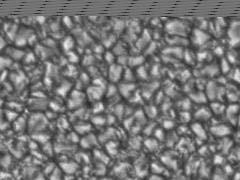The Solar Photosphere
When we examine the Sun in unfiltered light we are looking at the solar layer called the photosphere (literally "light ball" from the Greek). This is the layer from which most of the heat and light that we receive from the Sun originates. It is sometimes referred to as the solar "surface", although the density of the gaseous hydrogen and helium at the photosphere is only about 1/100 of the sea-level atmospheric density on Earth.
On looking at the photosphere, we can see up to four different types of features. These are, in order of ease of observation: sunspots, faculae, granulation and super-granulation.
Sunspots
Sunspots are the easiest feature to detect on the solar photosphere. In fact, some sunspot groups grow so large that they are visible with the naked eye (suitably protected of course). They are apparent as dark spots, with a central dark umbra and a lighter surrounding penumbra. They occur due to high concentrations of magnetic field (up to several thousand gauss) which inhibit heat flow to the surface from the convection zone below.
Faculae
Faculae are bright areas that are only seen near the limb where the apparent photospheric intensity decreases due to "limb darkening". These features are seen better at the H-alpha wavelength of 656.3 nm, where they are known as "plage" areas. They, like all features on the Sun, are due to strong magnetic fields, which in this case channel excess heat to the surface in these areas.
Granules
If you have a very well designed solar telescope and you are able to convince the Earth's atmosphere to stay quiet and still for long enough (being on a nice high mountain helps), you will see, under high magnification, small cells called granules covering the entire photosphere. Observed from the ground, granulation is best observed in green light. This is the convective activity of the Sun expressed at the surface.

The bright cells or granules are on average about 1100 km across and they are separated from each other by dark lanes which are about 200 km wide. Individual granules are only short lived. Their average lifetime is around 10 minutes, with a range from about 8 to 15 minutes.
Granules are believed to be the tops of convection cells where hot fluid (gas and plasma) rises up from the interior convection zone. This material spreads out across the surface, cools, and then sinks downward along the dark lanes. The vertical convection velocity averages about 2 km/s, although it can reach 7 km/s.
These are supersonic speeds in the solar atmosphere, and upwelling currents can create sonic booms. This release of acoustic energy generates waves in the photosphere.
Solar granules cover the entire photospheric surface, except where there are sunspots. In sunspot regions convection is inhibited and there are thus no granules (convection cells). There are approximately 4 million granules that cover the solar surface at any one time.
Supergranulation
This is the hardest of all to see, and is best seen in velocity images (showing Doppler shift) of the photosphere. Supergranulation is a much larger version of granulation. where large groups of granules seem to move together. The speed of movement is about 500 metres/s The fluid motion of supergranules carries magnetic field bundles across the photosphere.






